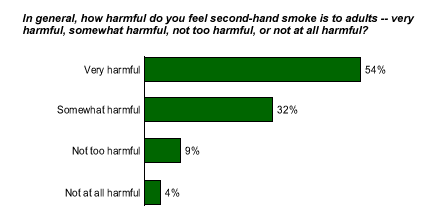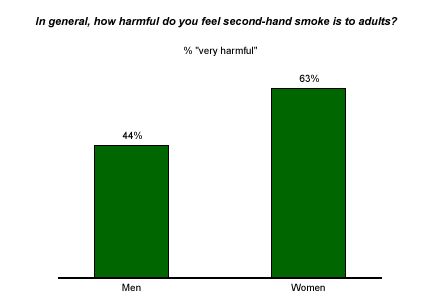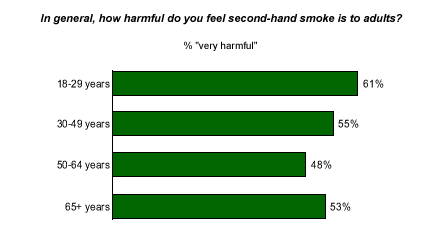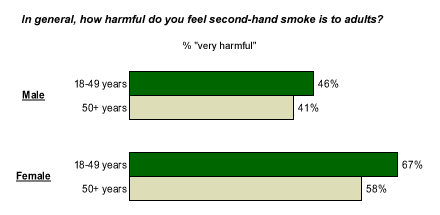Persistent complaints and health concerns about the harmful effects of second-hand smoke have lit a fire under many state and local governments across the country to ban cigarette smoking in bars, restaurants, and other workplaces. Although opponents of smoking bans argue that the possible harmful effects of second-hand smoke have been exaggerated, what do Americans believe?
Aggregated data from three years of polling on the subject show that a majority of Americans -- 54% -- believe that second-hand smoke is "very harmful" to adults. Another 32% believe second-hand smoke is "somewhat harmful," while just 13% feel that second-hand smoke is "not too harmful" or "not at all harmful."

Women, Young Adults More Likely to View Second-Hand Smoke as Harmful
Women are significantly more likely than men to view second-hand smoke as very harmful -- 63% vs. 44%, respectively. Sixteen percent of men, compared with 8% of women, feel that second-hand smoke is not too harmful or not at all harmful.

Age also seems to play a role in whether people view second-hand smoke as harmful. About 3 in 5 adults aged 18 to 29 feel second-hand smoke is very harmful, significantly more than do those in the older age groups -- belief that it is very harmful generally declines with age.

Gender appears to play a larger role than age does in people's perceptions about second-hand smoke. Less than a majority of men under age 50 (46%) and over age 50 (41%) view second-hand smoke as very harmful, and younger men are only slightly more likely than older men to hold this view. On the other hand, a majority of older and younger women believe second-hand smoke to be very harmful. There is a larger age gap among women than men. Women under 50 are significantly more likely than women aged 50 and older to feel this way (67% compared with 58%).

Bottom Line
The U.S. Centers for Disease Control and Prevention estimates that 60% of Americans show biological evidence of second-hand smoke exposure, and that second-hand smoke causes 35,000 deaths from coronary heart disease and 3,000 deaths from lung cancer among adult nonsmokers each year. Given these statistics, it's no surprise that 86% of Americans view second-hand smoke as at least somewhat harmful. Men, however, seem to require a little more convincing than women do.
*Results are based on telephone interviews with 3,016 national adults, aged 18 and older, conducted in July 2002, July 2003, and July 2004. For results based on this sample of national adults, the maximum margin of sampling error is ±2 percentage points.
For results based on the sample of 960 men and 1,050 women, the maximum margin of sampling error is ±3 percentage points.
For results based on the sample of 549 U.S. adults, aged 18-29 the maximum margin of sampling error is ±4 percentage points. For results based on the sample of 1,257 U.S. adults, aged 30-49, the maximum margin of sampling error is ±3 percentage points. For results based on the sample of 693 U.S. adults, aged 50-64, the maximum margin of sampling error is ±4 percentage points. For results based on the sample of 493 U.S. adults, aged 65+ the maximum margin of sampling error is ±4 percentage points.
For results based on the sample of 555 men, aged 18 to 49 and 566 women, aged 18 to 49, the maximum margin of sampling error is ±4 percentage points.